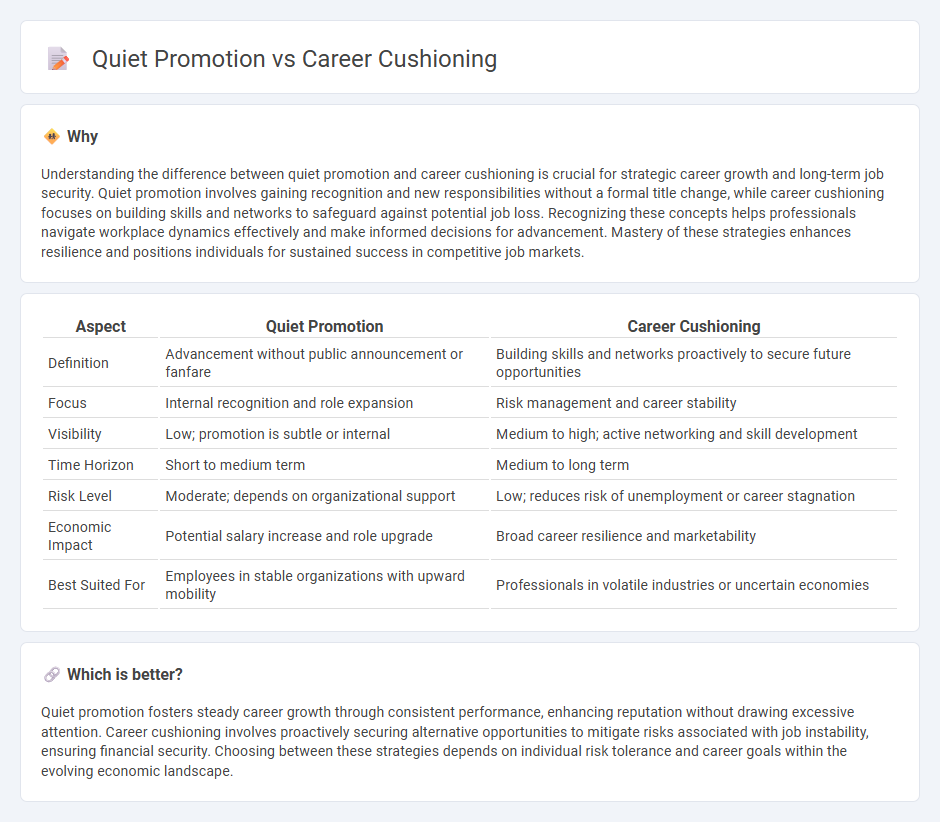
Quiet promotion involves gaining increased responsibilities or pay without formal announcements, allowing subtle career advancement within an organization. Career cushioning focuses on building skills and connections outside the current role to secure future job opportunities or transitions. Explore these strategies further to optimize your professional growth in a competitive economy.
Why it is important
Understanding the difference between quiet promotion and career cushioning is crucial for strategic career growth and long-term job security. Quiet promotion involves gaining recognition and new responsibilities without a formal title change, while career cushioning focuses on building skills and networks to safeguard against potential job loss. Recognizing these concepts helps professionals navigate workplace dynamics effectively and make informed decisions for advancement. Mastery of these strategies enhances resilience and positions individuals for sustained success in competitive job markets.
Comparison Table
| Aspect | Quiet Promotion | Career Cushioning |
|---|---|---|
| Definition | Advancement without public announcement or fanfare | Building skills and networks proactively to secure future opportunities |
| Focus | Internal recognition and role expansion | Risk management and career stability |
| Visibility | Low; promotion is subtle or internal | Medium to high; active networking and skill development |
| Time Horizon | Short to medium term | Medium to long term |
| Risk Level | Moderate; depends on organizational support | Low; reduces risk of unemployment or career stagnation |
| Economic Impact | Potential salary increase and role upgrade | Broad career resilience and marketability |
| Best Suited For | Employees in stable organizations with upward mobility | Professionals in volatile industries or uncertain economies |
Which is better?
Quiet promotion fosters steady career growth through consistent performance, enhancing reputation without drawing excessive attention. Career cushioning involves proactively securing alternative opportunities to mitigate risks associated with job instability, ensuring financial security. Choosing between these strategies depends on individual risk tolerance and career goals within the evolving economic landscape.
Connection
Quiet promotion often involves subtle recognition and low-key advancement opportunities that help employees secure a stable path within an organization. Career cushioning complements this by allowing individuals to gradually build skills, expand networks, and enhance credentials without overtly pursuing rapid promotion. Together, these strategies provide a balanced approach to career growth, reducing risks while positioning employees for long-term economic resilience and success.
Key Terms
Job Security
Career cushioning involves proactively building skills and networks to secure future job stability, while quiet promotion focuses on increasing responsibilities and visibility within the current role without formal announcements. Both strategies enhance job security by either preparing for external opportunities or solidifying internal standing. Explore effective methods to balance career cushioning and quiet promotion for maximum job security.
Upward Mobility
Career cushioning involves preparing alternative job options to safeguard against employment risks, enhancing job security and upward mobility. Quiet promotion emphasizes subtle recognition and incremental responsibility increases within an organization, often leading to upward mobility without formal promotion announcements. Explore how these strategies impact your career advancement and professional growth.
Employee Engagement
Career cushioning involves discreetly preparing for alternative job opportunities to enhance employee engagement by reducing anxiety about job security. Quiet promotion emphasizes recognition and growth within the current role without formal announcements, boosting morale and long-term commitment. Discover how integrating these strategies can transform your workforce engagement and retention.
Source and External Links
What is Career Cushioning and How Can it Impact Business? - Indeed - Career cushioning is when employees keep other career options open by building networks, upskilling, or side gigs to prepare for job uncertainty, helping them "hope for the best, prepare for the worst" in an unpredictable market.
The importance of career cushioning in today's job market - Career cushioning acts as an insurance policy against professional volatility by creating alternate career paths through upskilling, reskilling, or joining financially stable organizations, especially after pandemic-related uncertainties.
What Is Career Cushioning and Can It Lead to Success? - BetterUp - Career cushioning is the proactive development of backup career plans such as freelance work, side hustles, or skill-building to gain confidence during uncertain job situations, although it may also bring challenges like distraction or conflict of interest.
 dowidth.com
dowidth.com